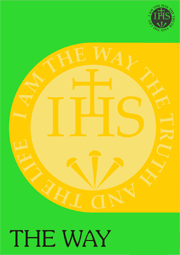|

| |
SPIRITUALITY, TRADITION AND BEAUTY a Special Number in honour of Hans Urs von Balthasar (1905-1988)
Please click here to subscribe to The
Way, Electronic subscribers, click here to download this issue. You will need the password that we e-mailed to you. Contents The Beauty of Christ A meditation on a sermon of Augustine’s about the beauty of Christ in every phase of his existence: his eternal generation; his incarnation, his cross and resurrection; his return to heaven. Caravaggio and the Resurrection of the Body How three great paintings by Caravaggio convey and nourish Christian faith in the resurrection of the body and soul-faith which involves commitment as well as assent. Download this article in
Word format by clicking here, Responding to Beauty's Call: The Shape of an Aesthetic Spirituality When we awaken to the call of beauty, we become aware of new ways of being in the world. Christine Valters Paintner considers how beauty, both natural and artistic, can nourish the spiritual life. Hans Urs von Balthasar-Theologian of Beauty An introduction to the life of the great theologian whom this collection celebrates, and an exploration of beauty’s role in his thought. On Pilgrimage to Chartres: Honouring the Centenary of Hans Urs von Balthasar’s Birth How one great building, the cathedral in Chartres, can open our hearts and spirits to prayer. ‘Blessed Tension’: Barth and Von Balthasar on the Music of Mozart Both von Balthasar and the great Reformed theologian, Karl Barth, lived in Basel. They became friends, and Barth was a major influence on von Balthasar’s work. Philip McCosker looks at the shared love of Mozart’s music that contributed much to their friendship. Download this article in
Word format by clicking here, Von Balthasar and the Office of Peter in the Church How von Balthasar developed a vision of the Church as the interplay of different charisms, each of which contributes to the richness of the whole. Hans Urs von Balthasar and Ignatius Loyola Von Balthasar thought of himself as a dramatic theologian. A long-standing friend and editor of von Balthasar’s work looks at what this dramatic theology owed to the Ignatian Exercises and at how it can help us understand better the Contemplation to Attain Love. The Divided Self, the Encounter with Christ, and the Journey of Commitment: Ignatius, Von Balthasar and the Human Condition In the Spiritual Exercises, sinful humanity confronts a God whose will is to save the whole human race, and who draws us into the implementation of that project. Erhard Kunz shows how this vision shapes not only Ignatius’ writing, but also von Balthasar’s massive theology. Tradition and the Icon Icons have become familiar well beyond the boundaries of Orthodox Christianity. Andrew Louth here explains the rich sense of Tradition which they express, and explores how the practice of icon painting has changed over time. Sex, Death and Melodrama: A Feminist Critique of Hans Urs von Balthasar A look at the problems raised by von Balthasar’s richly symbolic theology for many feminists, particularly when people use it to support restrictive positions about women’s vocations.
From the Foreword This special number of The Way honours Hans Urs von Balthasar’s centenary, and focuses chiefly on one theme in his work: what Gerald O’Collins refers to as the beauty of Christ. But the essays range far more widely in their explorations of beauty and God. Thomas J. McElligott considers some late paintings of Caravaggio; Philip McCosker looks at why both von Balthasar and his great Protestant contemporary and fellow Swiss, Karl Barth, were fascinated by the music of Mozart; Leo O’Donovan explores the architecture of Chartres cathedral. Christine Valters Paintner presents a more general account of a spirituality centred on beauty, while Joan L. Roccasalvo introduces us to von Balthasar’s life and to the theme of beauty in his work.One can only be selective with Von Balthasar. His achievement is massive, and it is only now, as we go to press, that English translations of the final volumes of his major three-part work are being announced. Probably no one is yet in a position fully to appreciate how his work as a whole holds together. His legacy appears at present as a set of fascinating, controversial fragments, often pointing in different directions. An immensely learned man, von Balthasar nevertheless attributed his theology in large part to the revelatory experiences of Adrienne von Speyr. Some reactionary forces in the Church may have adopted von Balthasar as their court theologian, particularly as regards women and vocation (a theme explored trenchantly here by Tina Beattie). Nevertheless, von Balthasar’s theology of Church and authority was rich, nuanced and pluralist, as John McDade admirably shows. Moreover, von Balthasar’s belief that we may at least hope for universal salvation (one that Erhard Kunz’s essay suggests may be prefigured in Ignatius), leads some authoritarian figures to be highly suspicious of him. … it embraces the most abysmal ugliness of sin and hell by virtue of the condescension of divine love, which has brought even sin and hell into that divine art for which there is no human analogue.
We may begin with Mozartian elegance, with the kind of writing that T.S. Eliot evoked at the end of ‘Little Gidding’:The common word exact without vulgarity,
But such easy graciousness eventually breaks down; the Incarnation we only half understand confronts us with the more mysterious beauty that Eliot evokes in ‘The Dry Salvages’:The formal word precise but not pedantic, The complete consort dancing together. … music heard so deeply
That it is not heard at all, but you are the music While the music lasts. Philip Endean SJ
Please click here to subscribe to The
Way, | ||
| |






|



